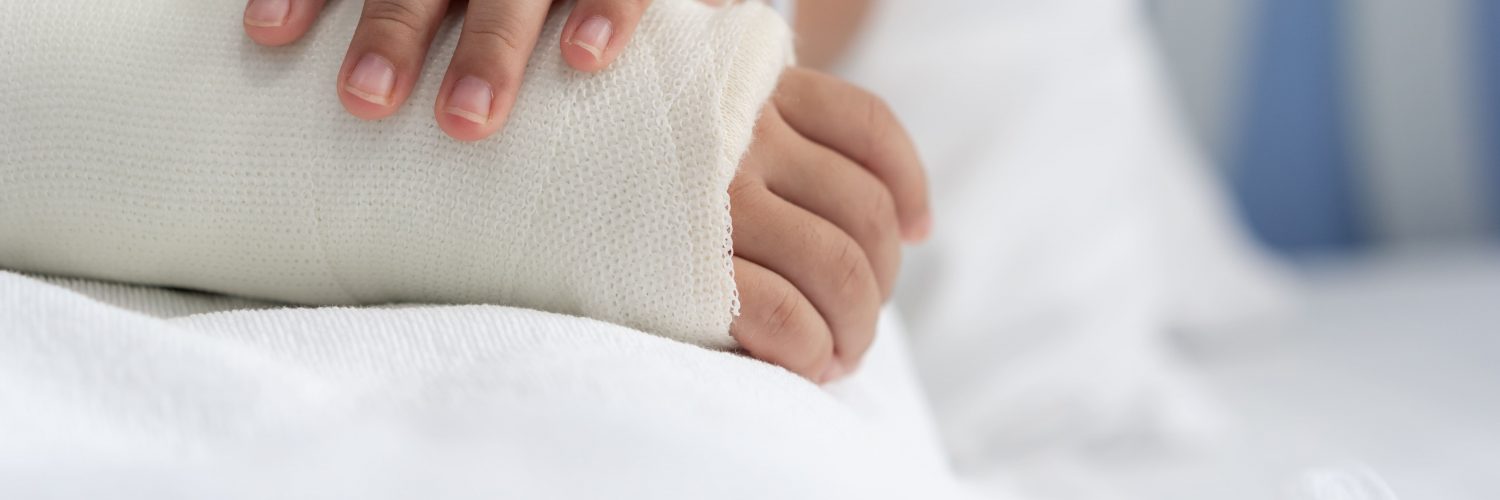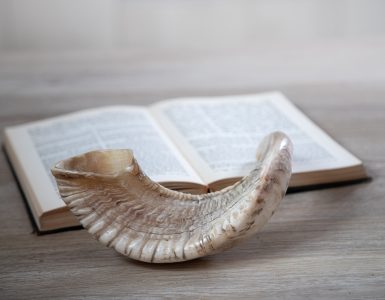Casts are applied to immobilize fractured limbs in order to promote healing and avoid further injury to bones, joints, or muscles. They can also prevent and relieve pain due to the injury. Plaster casts are made from gypsum, an extremely soft mineral composed of calcium and sulfate, usually found in layers of soft rocks. Gypsum powder (also known as plaster of Paris) is made by heating quarried gypsum to 130°C in a kiln, leading to evaporation of 75% of the water stored in its chemical structure and a resultant dry, white powder. This powder sets into a hard mass when combined with water, and is therefore an ideal substance for use in casts.
Applying a cast on Shabbos is likely to violate several Issurim d’Oraisa. Therefore, it is important to understand how they are prepared. In the past, casts were prepared manually. Water was poured into the gypsum powder, and the mixture was kneaded to form a thick paste that was applied to the affected area.
Today, casts come in the form of gauze bandages coated with dry polymer. In order to apply the cast, a flexible sleeve is placed on the limb as a first layer. This separates the limb from the cast and allows flexibility and ventilation. Additional padding is applied to protect the injured limb, and the bandage is dipped in warm water and wrapped around the limb. Within a few seconds the cast begins to dry but is still moist and warm. It remains soft and brittle for up to an hour, and the drying and hardening is completed between 24-48 hours. During that time, a failure to properly support the limb may result in a facture or deformation of the cast, and thus interfere with the healing process.
Utilizing the old method of cast preparation on Shabbos in extremely problematic. HaGaon Rav Asher Weiss Shlit”a (Minchas Asher 3:129)[1] notes that it likely violates several Melachos:
- Lash – Kneading
There is a Machlokes in the Gemara, and among the Rishonim, as to whether pouring water into flour violates the Melacha of Lash, even if the mixture is not subsequently kneaded. The Mishna Berura (321:50) summarizes the opinions and concludes that it is proper to be stringent and consider this a bona fide act of Lash. Since gypsum powder is mixed with water and becomes a thick paste when making casts, it is in contravention of this Melacha. This is also the conclusion of the Shemiras Shabbos Kehilchasa (16:13).
The Sefer, Noam Shabbos (p37) considers the preparation of casts to be “Lisha Avah” (a preparation of a thick paste). However, it is only a Tolda of Lash because the cast is inedible.
The Sefer, Ayil Meshulash (12, Lash) concurs:
It is evident from the Yerushalmi (Shabbos 7:2) that a person who mixes lime or gypsum [with water] is liable… Therefore, a person who mixes water with dry limb in order to paint with it, or mixes gypsum in order to fill a hole or apply a cast to a broken bone, is liable. Likewise, if a bone broken and the limb is at risk, where it is permissible to apply a cast on Shabbos, the gypsum should be mixed and applied by a non-Jew.
- Memareach – Smoothing Over
When a cast is applied, it needs to be smoothed over so that it fits correctly and solidifies in the correct shape. This is a violation of the Melacha of Memareach, as noted by the Shemiras Shabbos Kehilchasa (16:13).
- Sochet – Squeezing out Liquid
The person who applies the cast often needs to squeeze out the excess liquid when he removes it from the water.
- Boneh – Building
Shaping the cast and smoothing it into a specific shape and structure may be a violation of the Melacha of Boneh. This is also the conclusion of the Shemiras Shabbos Kehilchasa (16:13). Rav Shlomo Zalman Auerbach zt”l (Shulchan Shlomo, Shabbos 2, 314:1) forbids pouring water onto cement or plaster for this reason.
- Makeh b’Patish – The Final Hammer Blow
The Melacha of Makeh b’Patish is defined by the Gemara (Shabbos 75b) as an act which constitutes “G’mar Melacha” – the completion of the Melacha. Rashi (ad. loc. s.v. “Makeh b’Patish”) explains that the term “Makeh b’Patish” – “a hammer blow” is a reference to the striking of the hammer on an anvil to smoothen it at the completion of its work. In other words, it is not only creative acts that constitute Melachos, but any act of completion. Since, when applying a cast, a medical provider completes the task by giving it its final design, it may be considered Makeh b’Patish.
Clearly, any concern of Pikuach Nefesh overrides the Halachos of Shabbos and medical treatment may be performed to preserve a patient’s life.[2] With regard to broken bones, the rule is that any open fracture, or fracture of the longer bones where the two ends of the bone are not in line, is considered a Sakana and Chilul Shabbos is permissible, even if it is doubtful whether the patient is in danger. A possible skull fracture is also a matter of Pikuach Nefesh and one may travel to the hospital for x-rays or other scans as necessary. However, where this isn’t the case, one may not perform Melachos d’Oraisa, and a Jewish person should not perform the scans nor apply the cast. He may, however, apply a temporary bandage and wait until Motzaei Shabbos.
We should note that if there is any concern that the patient’s condition will worsen and his life will be endangered, and his physician contends that a temporary bandage until Motzaei Shabbos will not suffice, it is permissible to apply the cast on Shabbos (Shemiras Shabbos Kehilchasa 35:5).
Sometimes, failure to apply a cast to an injured limb, may endanger the long-term health of that limb, although it may not endanger the patient’s life. This is known as “Sakanas Eiver” and is considered an intermediate state between “Choleh she’Ein Bo Sakana” and Pikuach Nefesh. It is permissible to ask a non-Jew to perform Melachos d’Oraisa for a patient with Sakanas Eiver. Therefore, if the view of the physician is that failure to perform a scan or apply a cast to an injured limb is likely to endanger it, it is permissible to ask a non-Jew to perform the scan or apply the cast.
The same applies if the injury causes the patient a great deal of pain, such that his entire body cannot function correctly and he is compelled to lie down (“Nofel l’Mishkav”). If treatment can alleviate the pain (which is often the case with broken bones), it is permissible to ask a non-Jew to perform it.
However, if there is no Sakanas Eiver, nor is the patient Nofel l’Mishkav, one may not ask a non-Jew to perform Melachos d’Oraisa (Shulchan Shlomo, Erkei Refua 2, p116, Chut Shani 328:11, and Nishmas Avraham 1, 328:49).
HaGaon Rav Asher Weiss Shlit”a comes to many of these conclusions in his Sefer Minchas Asher (2:39). He therefore rules that when there is no Sakana a non-Jew should be enlisted to prepare and apply a cast for an injured limb.
All of the above applies to the traditional method of preparing and applying casts. Recently, a new type of cast has been invented known as MAGICAST. MAGICAST employs a method by which a soft, fabric sleeve is wrapped over the affected limb and a second sleeve made of a soft and adhesive material is placed on top of it. The sleeve is immersed in warm water and the wet cast is then wrapped around the limb. Within seconds the cast begins to dry until it hardens.
HaGaon Rav Asher Weiss Shlit”a (Minchas Asher 3:129) permits the use of a MAGICAST on Shabbos because it does not violate any Issurim d’Oraisa as the Melachos occur by themselves:
Using this material poses no concern of any of the aforementioned Melachos. There is no powdery substance and it does not form a “dough” or paste at all. Instead, the water causes a chemical reaction that causes the material to harden after several minutes. The person applying the cast does not flatten or smoothen, nor does he design the cast at all. Therefore, there is no concern of Lash, Sochet, Memareach, or Boneh.
We should point out that that after the sleeve is wrapped on the limb, it adjusts itself to the structure of the limb. This could perhaps be a concern of Makeh b’Patish.
We asserted above that Makeh b’Patish is any act that constitutes “G’mar Melacha”. This is the view of several Rishonim. However, the view of other Rishonim (discussed at length by Rav Asher in his Teshuvos – see, in particular, Minchas Asher 2:33 & 34) is that any “Melacha Chashuva” (significant Melacha) is Makeh b’Patish, even if it is not G’mar Melacha.
There is, moreover, a broad discussion by the Poskim, as to whether an act which causes a Melacha to be completed on its own accord constitutes Makeh b’Patish. Rashi (Shabbos 74b s.v. “Tanur”) holds that it does not. See Rav Shlomo Zalman Auerbach zt”l’s discussion of this issue in the Sefer Binyan Shabbos (13:3).
Rashi’s position can seemingly only be understood if Makeh b’Patish is an act of G’mar Melacha. If so, if the person did not perform the G’mar Melacha (as his action was at an earlier stage), he cannot be liable (as liability is only incurred for the act of performing the G’mar Melacha itself, not for the act of producing the result of eventual G’mar Melacha). If the definition of Makeh b’Patish is “Melacha Chashuva”, it should make little difference that the Melacha was completed of its own accord. If he would have been liable for completing it directly he should also be liable for causing it to occur – either way his action is a Melacha Chashuva.
However, it could be argued that Rashi’s position may also be understood if the definition of Makeh b’Patish is Melacha Chashuva. Other Melachos are based upon the notion of performing a “creative act” (like building or cooking) – there is, therefore, an argument to say that a person should be liable even if a Melacha is completed of its own accord, if it was instigated by him. However, Makeh b’Patish is entirely based on “Chashivus” (significance), which is not determined by the outcome of the act but by the nature of the act. Therefore, if a Melacha is completed of its own accord, it cannot be considered a Melacha Chashuva. (The Poskim similarly argue that a person cannot be liable for Makeh b’Patish if he had no intention to perform a Melacha, unlike other Melachos for which one is liable in cases of Pesik Reisha – where the outcome is inevitable.)
It would seem that this is why a person would not violate the Melacha of Makeh b’Patish by applying a cast. The act of fitting the cast is insignificant before it hardens, and is also a relatively inconsequential act (as the cast fits the limb even before he does so – he does not smooth out the material or reshape it). Therefore, it should be considered a Melacha which is completed of its own accord which does not constitute Makeh b’Patish, as stated.
We will close with two further comments.
Regarding the removal of a cast, there is usually no urgent need to remove a cast on Shabbos. However, occasionally the cast may cause a medical issue, such as if it is occluding blood flow to the extremity. If there is any concern of danger to the patient’s life, such as a lack of perfusion to the limb, some Poskim permit the removal of the cast on Shabbos (though it is preferable if it is removed by a non-Jew or by means of a Shinui).
Regarding going out to a Reshus haRabim while wearing a cast, the Sefer Oholei Yaakov (1:15) permits wearing a cast in a Reshus haRabim where there is no Eruv. The reason is that the cast is Tafel (subservient) to his body. However, a person who has his leg in a cast, can often not go outside without the aid of a cane or walker. May he take a cane or walker out to a Reshus haRabim on Shabbos?
The Shulchan Aruch (O.C. 301:17) rules:
A disabled person who is unable to walk without a cane may walk with it [outside on Shabbos] even if it isn’t attached to him. But if he is able to walk without it and only takes it to support himself – it is forbidden. (Rema: A sick person who is recovering has the same Halacha as a disabled person.)
This is based on the general rule stated by the Gemara in Shabbos (65b) that a person may walk outside with a cane on Shabbos (or a walker). The cane is considered “Tafel” to him – like his shoes – since he is unable to walk without it. However, since the Chachamim were concerned that he might come to carry the cane rather than walk with it, they only permitted it when he cannot walk without it at all.
The Mishna Berura (ibid.)[3] explains that if a person is able to walk without a cane (and without leaning on something else, such as a wall or railing) for a distance of four Amos (approximately 2 meters), he may not go out with a cane on Shabbos.
Therefore, a person whose leg is in a cast
and who cannot walk without a cane, may take a cane out to the Reshus haRabim. However, if he is able
to walk around his house without a cane and only takes it when he goes outside,
the Poskim disagree as to whether it is permissible. Those who are lenient have
Poskim upon whom to rely (see the Aruch
haShulchan ibid.), but the basic Halacha follows the Mishna Berura who rules stringently.
[1] The Sefer “b’Or Eish” (R’ Elisha Sharabi, Jerusalem, 2000) makes similar arguments (328:116).
[2] Orchos Shabbos 2, 20:53
[3] See also the Biur Halacha.














